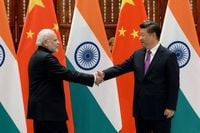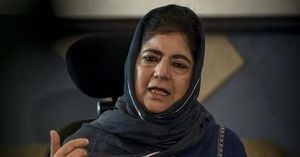As diplomatic fault lines deepen across the globe, the BRICS summit in Rio de Janeiro this week became the latest theater for high-stakes power plays and public rebukes. The 11-nation bloc, which now counts some of the world’s fastest-growing economies and several U.S. allies among its members, concluded its two-day gathering on August 19, 2025, with a pointed critique of U.S. President Donald Trump’s trade policies. In a statement that echoed around the world, BRICS leaders labeled Trump’s stop-start tariff wars as “indiscriminate,” damaging, and illegal—a move that drew a swift and fiery response from the White House.
Late Sunday night, President Trump took to social media to threaten additional tariffs: “Any Country aligning themselves with the Anti-American policies of BRICS, will be charged an ADDITIONAL 10% Tariff. There will be no exceptions to this policy.” The message was clear and uncompromising. Trump’s warning was not just a shot across the bow of traditional rivals like China and Russia but also a direct challenge to U.S. partners within the bloc, including Brazil, Saudi Arabia, and Indonesia. The timing and tone underscored the escalating tensions between Washington and the increasingly assertive BRICS coalition.
BRICS, originally conceived two decades ago as a forum for emerging economies, has grown into a sprawling and sometimes unwieldy alliance. Its members now represent about half the world’s population and 40 percent of global economic output, according to summit figures. But the group’s expansion has brought together a diverse—and at times divergent—set of nations: arch U.S. adversaries like Iran and Russia sit alongside countries with deep economic and military ties to Washington.
This year’s summit was marked by both symbolism and notable absences. Chinese President Xi Jinping, a fixture at such gatherings for over a decade, skipped the meeting for the first time in his 12 years as president. Russian President Vladimir Putin, facing war crimes charges related to Ukraine, also stayed away, choosing instead to participate via video link. Despite their physical absence, both leaders made their presence felt in the summit’s rhetoric and agenda.
China, widely seen as the driving force behind BRICS’ recent expansion, moved quickly to tamp down talk of confrontation. “China has repeatedly stated its position that trade and tariff wars have no winners and protectionism offers no way forward,” said Mao Ning, spokeswoman for the Chinese foreign ministry, on Monday. She described BRICS as “an important platform for cooperation between emerging markets and developing countries,” adding, “It advocates openness, inclusivity, and win-win cooperation. It does not engage in camp confrontation and is not targeted at any country.” Russia echoed this sentiment, with Kremlin spokesman Dmitry Peskov telling Russian media that BRICS cooperation “has never been and will never be directed against third countries.”
Yet the summit’s closing statement left little doubt about where the bloc’s sympathies currently lie. BRICS leaders condemned the recent U.S. and Israeli bombing of Iran’s nuclear facilities, a show of solidarity with fellow member Iran. This unified stance, particularly when paired with criticism of Trump’s trade maneuvers, signaled a willingness among BRICS nations to push back against what they see as American unilateralism.
The diplomatic dance was especially delicate for U.S. allies inside the bloc. Some, like Saudi Arabia, appeared keen to avoid Washington’s wrath—Riyadh kept its foreign minister away from Sunday’s talks and even skipped the BRICS group photo. Other members tried to soften the summit’s tone by not mentioning Trump or the United States by name in official statements. But these gestures did little to mollify the White House, as Trump’s tariff threat made abundantly clear.
Trump’s warning comes on the heels of earlier threats to impose unilateral levies on trading partners unless “deals” are reached by August 1. The president’s approach has become increasingly combative, with the new 10% tariff aimed squarely at countries perceived to be aligning with BRICS’ “anti-American” agenda. The move has rattled markets and left many governments scrambling to assess the potential fallout for their economies.
Against this backdrop, Indian Prime Minister Narendra Modi struck a markedly different note. On August 19, Modi welcomed what he described as improved ties with China, even as the U.S. ramped up pressure on New Delhi over its continued purchases of Russian oil. Modi announced plans to visit China later this month—his first trip there in seven years—signaling a thaw in relations between the two Asian giants. The timing is significant, coming just as BRICS seeks to present a more united front on the world stage.
Modi met with Chinese Foreign Minister Wang Yi in New Delhi, Wang’s first visit to India in three years. “India-China relations have made steady progress guided by respect for each other’s interests,” Modi posted on X, the platform formerly known as Twitter. He added, “Stable, predictable, constructive ties between India and China will contribute significantly to regional as well as global peace and prosperity.” The message, while diplomatic, underscored India’s desire to balance its growing role within BRICS with its longstanding ties to the United States.
Meanwhile, U.S. Treasury Secretary Scott Bessent escalated criticism of India for its purchases of Russian oil, highlighting the complex web of alliances and rivalries that now define global geopolitics. The U.S. has long pressured New Delhi to reduce its energy ties with Moscow, but India has so far resisted, citing national interests and the need for affordable energy supplies.
The Rio summit also laid bare the challenges facing BRICS as it seeks to navigate an increasingly polarized world. While the bloc projects itself as a champion of emerging markets and a counterweight to Western dominance, its members remain divided on key issues—from security to trade to relations with Washington. The absence of Xi and Putin was a reminder of the internal strains, even as the group’s collective voice grows louder.
For many observers, the summit’s drama was as much about what wasn’t said as what was. The careful choreography of statements, the diplomatic no-shows, and the veiled threats all pointed to a world order in flux. As Trump ratchets up the pressure with new tariffs and BRICS leaders close ranks in response, the coming months are likely to see even sharper debates about the future of trade, security, and global governance.
The events in Rio de Janeiro this week were a vivid illustration of the shifting sands beneath the world’s economic and political alliances. With leaders like Trump, Modi, and Xi charting their own courses, and blocs like BRICS testing the limits of cooperation, the only certainty is that the global stage will remain as unpredictable—and as fiercely contested—as ever.




